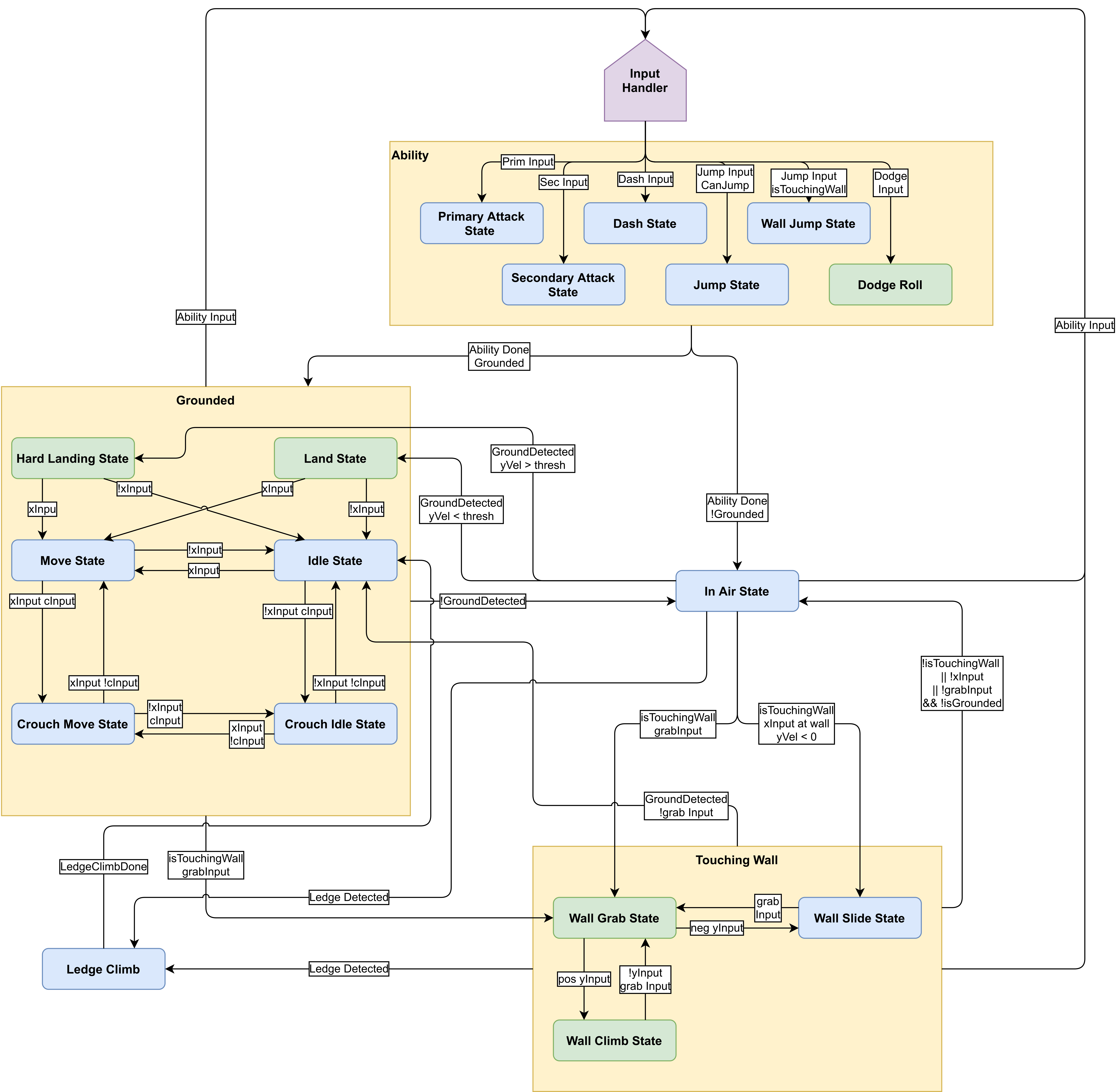Metroidvania Devlog 2: State Machine Player Controller

20/1/2023
Being quite tired of dealing with networking and multiplayer, I decided to start implementing the actual game. So I set out in search of something to serve as a starting point, and I found this amazing tutorial by Bardent: see the full playlist (note that the relevant videos start at part 20). So, while the videos do an excellent job at explaining everything, I might as well explain it myself.
Disclaimer: I'm not in any way trying to steal Bardent's content. Instead, I'm trying to explain how I started making the player controller.
The state machine
All the geniality of this player controller comes from its core idea: a state machine. For those of you that don't know, I'll try my best to explain what a state machine is.
Think of a collection of data, and a way to perform an action acknowledging that data (quite similar to what a class is in OOP). That is a state. If you have a collection of different states, which transition between them, you have a state machine.
This particular system has five main components:
- the
Playerscript, which has various functionalities - the
PlayerStateMachinescript, which updates states, and deals with transitions - the
PlayerStateabstract class, which serves as a base for other states - the
InputHandlerscript, which takes care of responding and managing input - the
PlayerDatascriptable object, which holds various parameters used by the states.
The PlayerState class
1 public class PlayerState { 2 protected Player player; 3 protected PlayerStateMachine stateMachine; 4 protected PlayerData playerData; 5 6 protected bool isAnimationFinished; 7 protected bool isExitingState; 8 protected float startTime; 9 protected string animBoolName; 10 11 public PlayerState(Player player, PlayerStateMachine stateMachine, PlayerData playerData, string animBoolName) { } 12 13 public virtual void Enter() { } 14 public virtual void Exit() { } 15 public virtual void LogicUpdate() { } 16 public virtual void PhysicsUpdate() { }; 17 public virtual void DoChecks() { } 18 public virtual void AnimationTrigger() { } 19 public virtual void AnimationFinishTrigger() { } 20 }
For the sake of brevity, I omitted most of the implementations. However, looking at the script it's easy to see what it does. Lines 2-4 hold references to useful components; lines 6-9 hold state inner data; line 11 is a default constructor; lines 13-19 have various functions. Enter(), LogicUpdate(), PhysicsUpdate() and Exit() are 'lifecycle' functions, and their names are pretty self-explanatory. DoChecks() contains various checks that a state needs to do at some points in the code. AnimationTrigger() and AnimationFinishTrigger() are used to hook into animation events, which is needed for some states.
The PlayerStateMachine component
This one is pretty simple: first, it's initialized with a default state. Then, it has only another function: ChangeState(), which calls Exit() on the current state, changes it to the new state, and then calls Enter() on it.
The Player component
At the start of this post, I stated that Bardent's player controller was amazing (and it is), but if I had to choose something I don't like about it, it'd be the Player script. It's a mishmash of random functionality:
- it holds an exhaustive list of all the
PlayerState's, so that states can change to other states, - it has functions to do common tasks like set the player's velocity,
- it has function to check certain conditions, like being grounded,
- and it has some more random functions.
However, it does work. Just not cleanly.
The structure of the State Machine

Diagram of the state machine Image by Bardent
The image is pretty obvious, but basically there is a set of states all hard-wired to transition to some other states (which I intend to change).
Conclusion
All things considered, this player controller is very good, but there is some room for improvement. I intend to make this system more generalist, modular and overall cleaner. However, for the next post we'll take a detour from coding. Because, in the meanwhile, I've been writing some lore. So the next post will be about my creative process: how I come up with ideas, and how I perfect them. I hope I'll have you with me again! Goodbye 'til then.